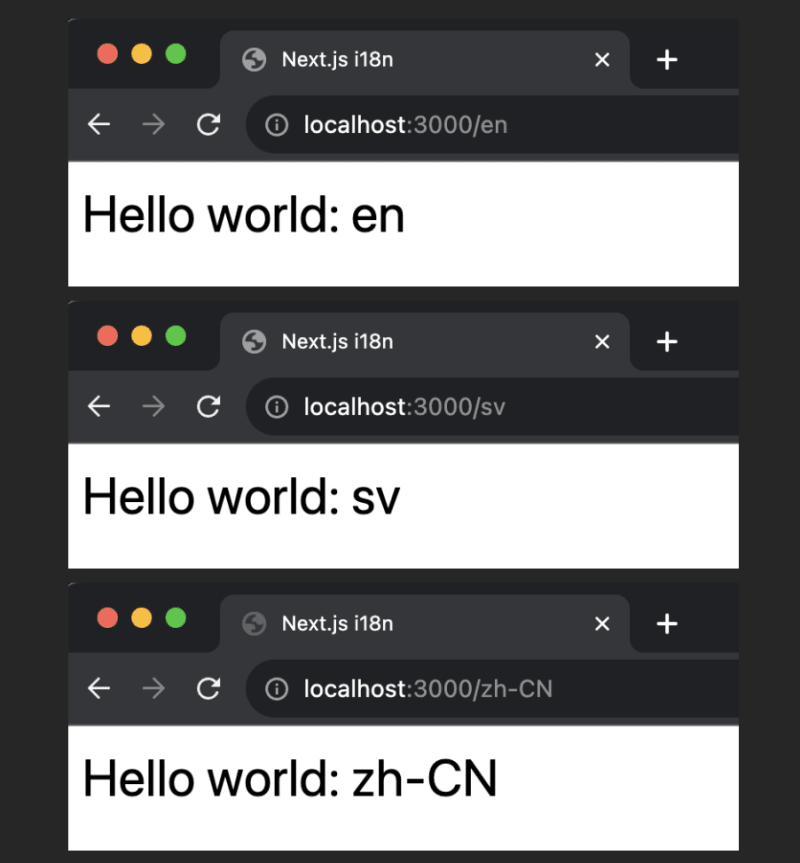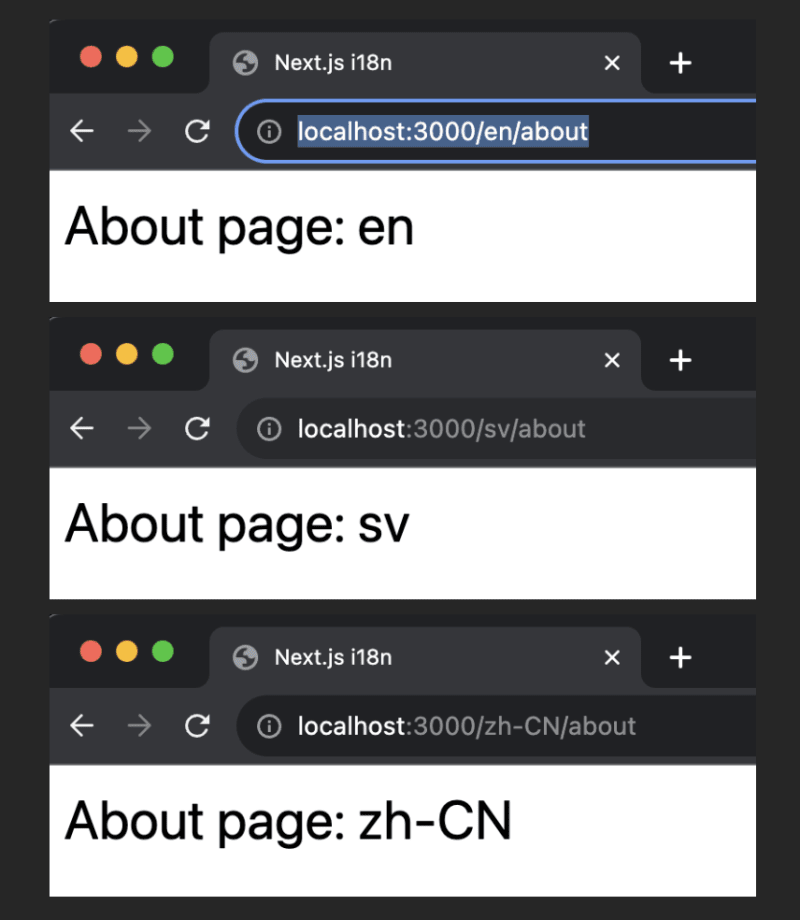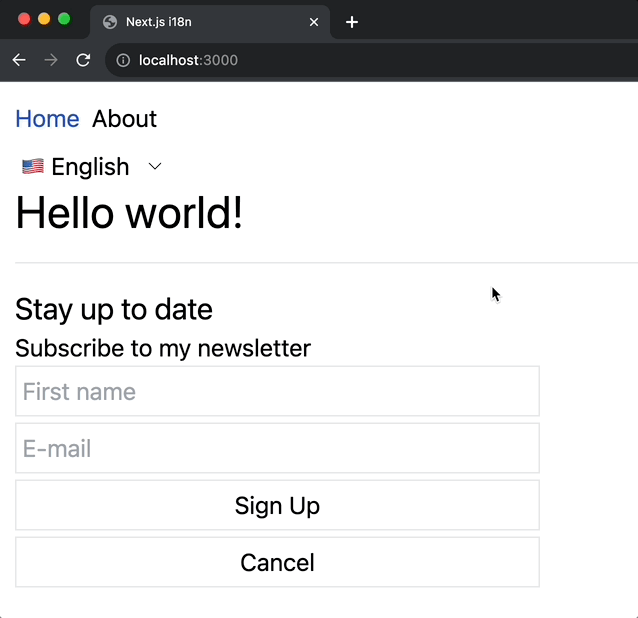Build a multilingual NextJS app using the new app directory

Carlo Gino Catapang
Posted on August 9, 2023

Learn how to build a multilingual NextJS app using the new app directory and i18next library
TL;DR
Check the demo here
Check the source code here
Introduction
Internationalization, or i18n for short, is the process of designing and developing software applications that can be adapted to different languages and cultures. It is an important consideration for any application that is intended for a global audience. Next.js is a popular framework for building web applications that simplifies the process of implementing i18n. In this article, we will explore how to handle i18n in Next.js using the app directory and the i18next library. We will also cover some of the key translation functions and techniques that you can use to make your application more accessible to users around the world.
With the introduction of app directory, my previous i18n blog is not applicable anymore since next-i18next is not necessary.
Installation
The easiest way to follow this guide is to degit a Nextjs boilerplate.
npx degit codegino/nextjs-ts-tw-tldr next13-i18n
I will be using TailwindCSS and TypeScript due to personal preference, but you can use plain CSS and JavaScript if you want.
Remove unused files
Delete everything under the app and components folders
rm -rf app/* components/*
Project Structure
Our i18n strategy
In this blog post, we will use a path-based strategy to determine the locale of our web application. Implementing this strategy in Next.js is easy because the framework follows a convention for creating paths. We will create a [locale] folder and place all our pages inside it. This means our folder structure should look like this:
app
└── [locale]
├── page.tsx
└── about
└── page.tsx
Since we're utilizing a path-based i18n approach, we can effortlessly obtain the locale from the params object that our page will receive.
Create our home page to display the locale
// app/[locale]/page.tsx
const IndexPage = ({params: {locale}}) => (
<div>
<h1>Hello world: {locale}</h1>
</div>
);
export default IndexPage;
Create another page to test navigation
// app/[locale]/about/page.tsx
const AboutPage = ({params: {locale}}) => (
<div>
<h1>About page: {locale}</h1>
</div>
);
export default AboutPage;
NextJS has a feature that automatically creates a layout component if we don't provide one. However, I prefer to create my own layout component because I need to basic customization.
// app/layout.tsx
import '../styles/tailwind.css';
export const metadata = {
title: 'Next.js i18n',
};
export default function RootLayout({children}) {
return (
<html lang="en">
<body className="p-3">{children}</body>
</html>
);
}
Testing our pages
We'll get a 404 page if we try to access the root URL because every page is now under the [locale] folder. We'll handle this later.
To see our page, we need to add the "locale" of our choice to the URL. For example, if we want to see the English version of our page, we need to add /en to the URL.
Locale switcher and navigation links
To simplify our demo, we'll create a component that will handle the locale switcher and navigation links.
Implement a new layout component to manage the organization of page content
We can put everything in the root layout if you prefer.
// app/[locale]/layout.tsx
import React from 'react';
import Header from '../../components/Header';
const Layout = ({children}) => {
return (
<>
<Header />
{children}
</>
);
};
export default Layout;
Create the Header component
This component will include the reusable navigation and locale switcher component
// app/components/Header.tsx
'use client';
import {usePathname, useParams} from 'next/navigation';
import Link from 'next/link';
import ChangeLocale from './ChangeLocale';
const Header = () => {
const pathName = usePathname();
const locale = useParams()?.locale;
return (
<header>
<nav className="flex gap-2 mb-2">
<Link
href={`/${locale}`}
className={pathName === `/${locale}` ? 'text-blue-700' : ''}
>
Home
</Link>
<Link
href={`/${locale}/about`}
className={pathName === `/${locale}/about` ? 'text-blue-700' : ''}
>
About
</Link>
</nav>
<ChangeLocale />
</header>
);
};
export default Header;
Create the locale switcher component
// app/components/ChangeLocale.tsx
'use client';
import React from 'react';
import {useRouter, useParams, useSelectedLayoutSegments} from 'next/navigation';
const ChangeLocale = () => {
const router = useRouter();
const params = useParams();
const urlSegments = useSelectedLayoutSegments();
const handleLocaleChange = event => {
const newLocale = event.target.value;
// This is used by the Header component which is used in `app/[locale]/layout.tsx` file,
// urlSegments will contain the segments after the locale.
// We replace the URL with the new locale and the rest of the segments.
router.push(`/${newLocale}/${urlSegments.join('/')}`);
};
return (
<div>
<select onChange={handleLocaleChange} value={params.locale}>
<option value="en">🇺🇸 English</option>
<option value="zh-CN">🇨🇳 中文</option>
<option value="sv">🇸🇪 Swedish</option>
</select>
</div>
);
};
export default ChangeLocale;
Now it's easier to test around what language and page we want to see.

Actual translation
We're done with the project setup. It's time to actually do some internationalization
Create translation files
Unless our users use translation plugins like Google Translate, there is no way for our content to be magically translated. Therefore, we need to determine how our pages will be translated based on the user's locale.
Here is what our translation files' structure will look like.
i18n
└── locales
├── en
│ ├── about.json
│ └── home.json
├── zh-CN
│ ├── about.json
│ └── home.json
└── sv
├── about.json
└── home.json
NOTE: It does not matter where you put the translation files as long as you can import them correctly.
English translations
// i18n/locales/en/home.json
{
"greeting": "Hello world!"
}
i18n/locales/en/about.json
{
"aboutThisPage": "This is the About page"
}
Chinese translations
// i18n/locales/zh-CN/home.json
{
"greeting": "世界您好"
}
// i18n/locales/zh-CN/about.json
{
"aboutThisPage": "这是关于页面"
}
Swedish translation
// i18n/locales/sv/home.json
{
"greeting": "Hej världen!"
}
// i18n/locales/sv/about.json
{
"aboutThisPage": "Det här är sidan Om"
}
Install required dependencies
There are various libraries available for handling translations, but I find libraries from i18next very easy to use.
npm install i18next react-i18next i18next-resources-to-backend
i18next-resources-to-backend is a very small utility, so you can just copy the implementation if you don't want an additional dependency.
Create a reusable settings file
Let's create a utility file for both the server and the client-side translations
// i18n/settings.ts
import type {InitOptions} from 'i18next';
export const fallbackLng = 'en';
export const locales = [fallbackLng, 'zh-CN', 'sv'] as const;
export type LocaleTypes = (typeof locales)[number];
export const defaultNS = 'common';
export function getOptions(lang = fallbackLng, ns = defaultNS): InitOptions {
return {
// debug: true, // Set to true to see console logs
supportedLngs: locales,
fallbackLng,
lng: lang,
fallbackNS: defaultNS,
defaultNS,
ns,
};
}
To learn more about the options, check out the i18next documentation.
Server Components translation
Create a utility for translations happening in the server/backend
// i18n/server.ts
import {createInstance} from 'i18next';
import resourcesToBackend from 'i18next-resources-to-backend';
import {initReactI18next} from 'react-i18next/initReactI18next';
import {getOptions, LocaleTypes} from './settings';
// Initialize the i18n instance
const initI18next = async (lang: LocaleTypes, ns: string) => {
const i18nInstance = createInstance();
await i18nInstance
.use(initReactI18next)
.use(
resourcesToBackend(
(language: string, namespace: typeof ns) =>
// load the translation file depending on the language and namespace
import(`./locales/${language}/${namespace}.json`),
),
)
.init(getOptions(lang, ns));
return i18nInstance;
};
// It will accept the locale and namespace for i18next to know what file to load
export async function createTranslation(lang: LocaleTypes, ns: string) {
const i18nextInstance = await initI18next(lang, ns);
return {
// This is the translation function we'll use in our components
// e.g. t('greeting')
t: i18nextInstance.getFixedT(lang, Array.isArray(ns) ? ns[0] : ns),
};
}
Translate the Home page
// app/[locale]/page.tsx
import {createTranslation} from '../../i18n/server';
// This should be async cause we need to use `await` for createTranslation
const IndexPage = async ({params: {locale}}) => {
// Make sure to use the correct namespace here.
const {t} = await createTranslation(locale, 'home');
return (
<div>
<h1>{t('greeting')}</h1>
</div>
);
};
export default IndexPage;
Translate the About page
// app/[locale]/about/page.tsx
import {createTranslation} from '../../../i18n/server';
// This should be async cause we need to use `await` for createTranslation
const AboutPage = async ({params: {locale}}) => {
// Make sure to use the correct namespace here.
const {t} = await createTranslation(locale, 'about');
return (
<div>
<h1>{t('aboutThisPage')}</h1>
</div>
);
};
export default AboutPage;
With the codes above, we can now see the content translated.

Client-side translation
One issue in the previous example is that the links in the header do not update accordingly to the selected language.
Create a reusable hook to use for translations
Install i18next-browser-languagedetector to simplify language detection in the frontend
npm install i18next-browser-languagedetector
The code below might be lengthy because we need to support both server rendering and client rendering. Don't confuse SSR with Server Component rendering.
// i18n/client.ts
'use client';
import {useEffect, useState} from 'react';
import i18next, {i18n} from 'i18next';
import {initReactI18next, useTranslation as useTransAlias} from 'react-i18next';
import resourcesToBackend from 'i18next-resources-to-backend';
import LanguageDetector from 'i18next-browser-languagedetector';
import {type LocaleTypes, getOptions, locales} from './settings';
const runsOnServerSide = typeof window === 'undefined';
// Initialize i18next for the client side
i18next
.use(initReactI18next)
.use(LanguageDetector)
.use(
resourcesToBackend(
(language: LocaleTypes, namespace: string) =>
import(`./locales/${language}/${namespace}.json`),
),
)
.init({
...getOptions(),
lng: undefined, // detect the language on the client
detection: {
order: ['path', 'htmlTag'],
},
preload: runsOnServerSide ? locales : [],
});
export function useTranslation(lng: LocaleTypes, ns: string) {
const translator = useTransAlias(ns);
const {i18n} = translator;
// Run when content is rendered on server side
if (runsOnServerSide && lng && i18n.resolvedLanguage !== lng) {
i18n.changeLanguage(lng);
} else {
// Use our custom implementation when running on client side
// eslint-disable-next-line react-hooks/rules-of-hooks
useCustomTranslationImplem(i18n, lng);
}
return translator;
}
function useCustomTranslationImplem(i18n: i18n, lng: LocaleTypes) {
const [activeLng, setActiveLng] = useState(i18n.resolvedLanguage);
// This effect updates the active language state variable when the resolved language changes,
useEffect(() => {
if (activeLng === i18n.resolvedLanguage) return;
setActiveLng(i18n.resolvedLanguage);
}, [activeLng, i18n.resolvedLanguage]);
// This effect changes the language of the application when the lng prop changes.
useEffect(() => {
if (!lng || i18n.resolvedLanguage === lng) return;
i18n.changeLanguage(lng);
}, [lng, i18n]);
}
Create the translations for the navigation links
We'll put the translations in the common namespace as they are shared common pages.
// i18n/locales/en/common.json
{
"home": "Home",
"about": "About"
}
// i18n/locales/zh-CN/common.json
{
"home": "主页",
"about": "关于页面"
}
// i18n/locales/sv/common.json
{
"home": "Hem",
"about": "Om"
}
Translate the Header component
// components/Header.tsx
'use client';
import {usePathname, useParams} from 'next/navigation';
import Link from 'next/link';
import ChangeLocale from './ChangeLocale';
import {useTranslation} from '../i18n/client';
import type {LocaleTypes} from '../i18n/settings';
const Header = () => {
const pathName = usePathname();
const locale = useParams()?.locale as LocaleTypes;
const {t} = useTranslation(locale, 'common');
return (
<header>
<nav className="flex gap-2 mb-2">
<Link
href={`/${locale}`}
className={pathName === `/${locale}` ? 'text-blue-700' : ''}
>
{t('home')}
</Link>
<Link
href={`/${locale}/about`}
className={pathName === `/${locale}/about` ? 'text-blue-700' : ''}
>
{t('about')}
</Link>
</nav>
<ChangeLocale />
</header>
);
};
export default Header;
Now the links will update accordingly to the selected language
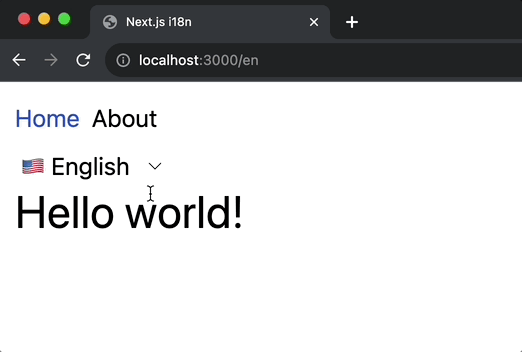
Handle default locale
This may vary based on the user's requirements, but I prefer not to include the default locale in the URL. I want localhost:3000 to be equivalent to localhost:3000/en, and when I visit localhost:3000/en, I want the /en in the URL to be automatically removed.
To achieve this, we need to do some URL rewriting and redirecting.
// middleware.ts
import {NextResponse, NextRequest} from 'next/server';
import {fallbackLng, locales} from './i18n/settings';
export function middleware(request: NextRequest) {
// Check if there is any supported locale in the pathname
const pathname = request.nextUrl.pathname;
// Check if the default locale is in the pathname
if (
pathname.startsWith(`/${fallbackLng}/`) ||
pathname === `/${fallbackLng}`
) {
// e.g. incoming request is /en/about
// The new URL is now /about
return NextResponse.redirect(
new URL(
pathname.replace(
`/${fallbackLng}`,
pathname === `/${fallbackLng}` ? '/' : '',
),
request.url,
),
);
}
const pathnameIsMissingLocale = locales.every(
locale => !pathname.startsWith(`/${locale}/`) && pathname !== `/${locale}`,
);
if (pathnameIsMissingLocale) {
// We are on the default locale
// Rewrite so Next.js understands
// e.g. incoming request is /about
// Tell Next.js it should pretend it's /en/about
return NextResponse.rewrite(
new URL(`/${fallbackLng}${pathname}`, request.url),
);
}
}
export const config = {
// Do not run the middleware on the following paths
matcher:
'/((?!api|_next/static|_next/image|manifest.json|assets|favicon.ico).*)',
};
NextJS is truly magical in making things just work

Bonus
Nested translation keys and default translation
We are not limited to a flat JSON structure.
// i18n/locales/en/newsletter.json
{
"title": "Stay up to date",
"subtitle": "Subscribe to my newsletter",
"form": {
"firstName": "First name",
"email": "E-mail",
"action": {
"signUp": "Sign Up",
"cancel": "Cancel"
}
}
}
We can omit some translation keys if we want it to use the default locale value(en in our case).
// i18n/locales/zh-CN/newsletter.json
{
"title": "保持最新状态",
"form": {
"email": "电子邮箱",
"action": {
"cancel": "取消"
}
}
}
// i18n/locales/sv/newsletter.json
{
"title": "Håll dig uppdaterad",
"subtitle": "Prenumerera på mitt nyhetsbrev",
"form": {
"firstName": "Förnamn",
"email": "E-post",
"action": {
"signUp": "Registrera sig",
"cancel": "Annullera"
}
}
}
Create the component
Let's create a component that uses the translations above. We'll make this a server component to demonstrate one way of passing the locale.
// components/SubscribeForm.tsx
import React from 'react';
import {createTranslation} from '../i18n/server';
// pass the locale as a prop
const SubscribeForm = async ({locale}) => {
const {t} = await createTranslation(locale, 'newsletter');
return (
<section className="w-[350px]">
<h3>{t('title')}</h3>
<h4>{t('subtitle')}</h4>
<form className="flex flex-col items-start">
<input placeholder={t('form.firstName')} className="form-field" />
<input placeholder={t('form.email')} className="form-field" />
<button className="form-field">{t('form.action.signUp')}</button>
<button className="form-field">{t('form.action.cancel')}</button>
</form>
</section>
);
};
export default SubscribeForm;
(OPTIONAL) Add styles to form fields
// styles/tailwind.css
// ...
.form-field {
@apply border mb-1 p-1 w-full;
}
Render the form on the home page
// app/[locale]/page.tsx
import SubscribeForm from '../../components/SubscribeForm';
import {createTranslation} from '../../i18n/server';
const IndexPage = async ({params: {locale}}) => {
// Make sure to use the correct namespace here.
const {t} = await createTranslation(locale, 'home');
return (
<div>
<h1>{t('greeting')}</h1>
<hr className="my-4" />
<SubscribeForm locale={locale} />
</div>
);
};
export default IndexPage;
Built-in Formatting
It is very easy to format most of our data since i18next comes with a lot of utilities we can use.
Let's use the translation files below to showcase the formatting features.
// i18n/en/built-in-demo.json
{
"number": "Number: {{val, number}}",
"currency": "Currency: {{val, currency}}",
"dateTime": "Date/Time: {{val, datetime}}",
"relativeTime": "Relative Time: {{val, relativetime}}",
"list": "List: {{val, list}}",
"weekdays": ["Monday", "Tuesday", "Wednesday", "Thursday", "Friday"]
}
// i18n/zh-CN/built-in-demo.json
{
"number": "数: {{val, number}}",
"currency": "货币: {{val, currency}}",
"dateTime": "日期/时间: {{val, datetime}}",
"relativeTime": "相对时间: {{val, relativetime}}",
"list": "列表: {{val, list}}",
"weekdays": ["星期一", "星期二", "星期三", "星期四", "星期五"]
}
// i18n/sv/built-in-demo.json
{
"number": "Nummer: {{val, number}}",
"currency": "Valuta: {{val, currency}}",
"dateTime": "Datum/tid: {{val, datetime}}",
"relativeTime": "Relativ tid: {{val, relativetime}}",
"list": "Lista: {{val, list}}",
"weekdays": ["Måndag", "Tisdag", "Onsdag", "Torsdag", "Fredag"]
}
Create the component
Let's create a component that will use the previous translations. We'll make it a client component just for fun.
// app/components/BuiltInFormatsDemo.tsx
'use client';
import React from 'react';
import {useTranslation} from '../i18n/client';
import type {LocaleTypes} from '../i18n/settings';
import {useParams} from 'next/navigation';
const BuiltInFormatsDemo = () => {
let locale = useParams()?.locale as LocaleTypes;
const {t} = useTranslation(locale, 'built-in-demo');
return (
<div>
<p>
{/* "number": "Number: {{val, number}}", */}
{t('number', {
val: 123456789.0123,
})}
</p>
<p>
{/* "currency": "Currency: {{val, currency}}", */}
{t('currency', {
val: 123456789.0123,
style: 'currency',
currency: 'USD',
})}
</p>
<p>
{/* "dateTime": "Date/Time: {{val, datetime}}", */}
{t('dateTime', {
val: new Date(1234567890123),
formatParams: {
val: {
weekday: 'long',
year: 'numeric',
month: 'long',
day: 'numeric',
},
},
})}
</p>
<p>
{/* "relativeTime": "Relative Time: {{val, relativetime}}", */}
{t('relativeTime', {
val: 12,
style: 'long',
})}
</p>
<p>
{/* "list": "List: {{val, list}}", */}
{t('list', {
// https://www.i18next.com/translation-function/objects-and-arrays#objects
// Check the link for more details on `returnObjects`
val: t('weekdays', {returnObjects: true}),
})}
</p>
</div>
);
};
export default BuiltInFormatsDemo;
Don't forget to render the component on the home page.
// app/[locale]/page.tsx
import BuiltInFormatsDemo from '../../components/BuiltInFormatsDemo';
import {createTranslation} from '../../i18n/server';
const IndexPage = async ({params: {locale}}) => {
// Make sure to use the correct namespace here.
const {t} = await createTranslation(locale, 'home');
return (
<div>
<h1>{t('greeting')}</h1>
<hr className="my-4" />
<BuiltInFormatsDemo />
</div>
);
};
export default IndexPage;
The more you look, the more you'll be amazed
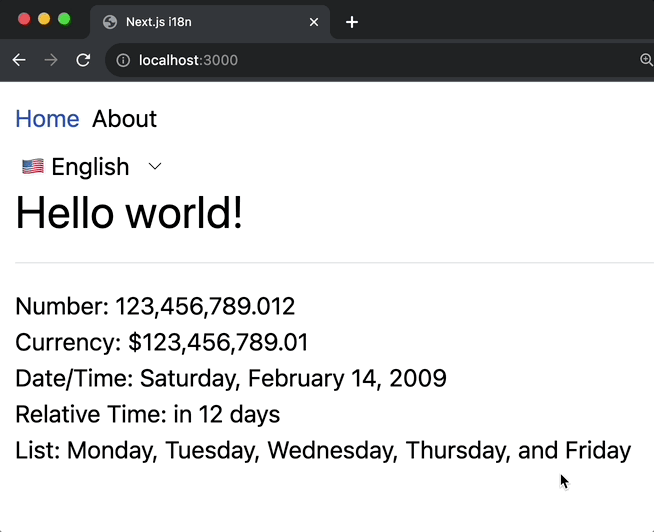
Other translation functions to check
Conclusion
Internationalization is a complex requirement simplified in Nextjs due to the way applications are built using the framework. With the introduction of app directory, we need a different approach to handle i18n. Because of i18next it makes the task even simpler.

Posted on August 9, 2023
Join Our Newsletter. No Spam, Only the good stuff.
Sign up to receive the latest update from our blog.

